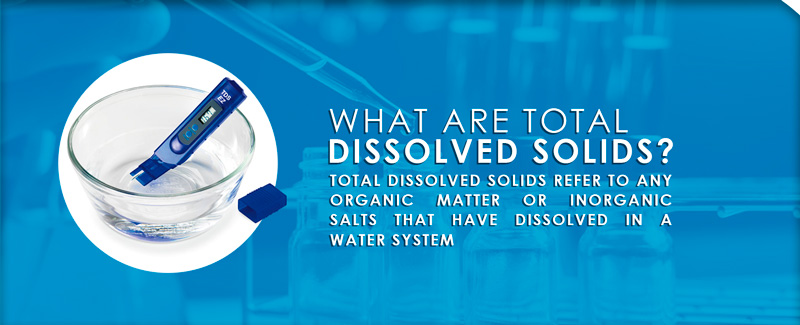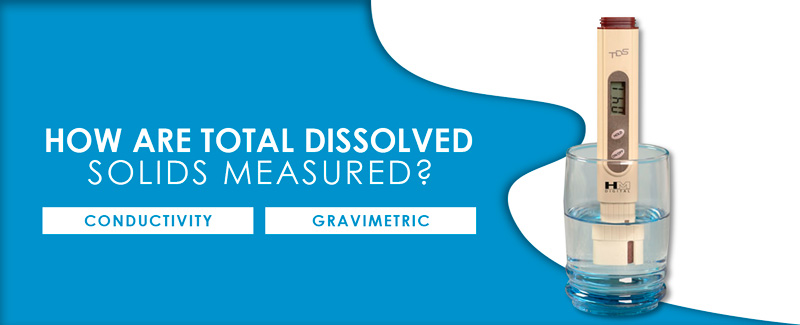The Truth About Total Dissolved Solids
Posted by Kenton Jones on Mar 21st 2024
Since the water crisis of
Flint, Mich., the nation has been more interested in its water quality than ever before in — but people are more nervous than ever, as well.
When most people hear the words "total dissolved solids" in the context of water, they instantly assume the worst.
Even water companies often label total dissolved solids (TDS) as bad for consumers, perpetuating the stereotype.
But total dissolved solids are not automatically dangerous pollutants or contaminants. Ultimately, the type of dissolved solids in your water is far more important than the amount. In this article, we'll reveal the truth about dissolved solids in your drinking water, including what they are, how they are measured, and what they really tell you about your water supply.
What Are Total Dissolved Solids?

Known as the universal solvent, water picks up impurities quickly and easily. While pure water is odorless, colorless, and tasteless, any additives can change its scent, color, and taste. For most American homes, the water that flows from the faucet is not considered "pure" — instead, it contains a variety of chemical additives and dissolved solids.
Total dissolved solids or TDS refers to any inorganic salts or organic matter dissolved in water. Most often, when total dissolved solids are measured, a test counts the sum of the anions and cations present in the sample — anions have a negative charge, and cations have a positive charge. A TDS meter gives a quantitative measure of the total amount of dissolved ions in the water, but it doesn't reveal what the dissolved substances are or their relationships.
Ultimately, this means a high TDS count in your water could mean high mineral content or high toxic organic matter. TDS measures solids in your water but doesn't give any indication of whether those solids are beneficial or harmful.
Types of Total Dissolved Solids
Total Dissolved Solids include various minerals, anions, metals, and cations dissolved in water. Most often, water with a registered TDS has inorganic salts and small amounts of organic matter.
The dissolved organic matter can include hydrocarbons, herbicides, and pollutants. Water from lakes, waterfalls, and springs contains microorganisms and salts — some natural water supplies even contain phytoplankton, a microscopic plant. Organic compounds derived from soil, such as fulvic and humic acids, are also considered dissolved solids.
Synthetic chemicals in drinking water commonly come from pharmaceutical drugs, urban and industrial runoff, and chemicals used in manufacturing processes.
Typically, the inorganic salts comprising the TDS content of water include the following compounds:
- Bicarbonates
- Calcium
- Chloride
- Iron
- Lead
- Magnesium
- Potassium
- Sodium
- Sulfates
- Zinc
A TDS test will only reveal that compounds are present in water, not the nature of the recorded compounds. A high TDS count could indicate the presence of organic pollutants or inorganic calcium and magnesium — further tests are required to determine the exact nature of the dissolved solids.
Sources of Total Dissolved Solids
With drinking water, TDS can come from either incidental or intentional sources.
1. Incidental Sources
Most often, dissolved solids come from water's contact with the environment during its journey from source to tap, or incidental sources. Organic compounds can originate from urban or agricultural runoff, industrial wastewater, sewage, chemicals used in water treatment, carbonate or salt deposits, seawater intrusion, stormwater, or even the water pipes that thread underneath towns and neighborhoods.
A common example is water drawn from a mineral spring — because the water in a mineral spring flows underground through rocks with high mineral content, the water brims with beneficial compounds such as salts, sulfur, magnesium, zinc, and iron.
2. Intentional Sources
Dissolved solids can be intentionally added to water. Grocery store shelves are stacked with supplemented bottled water. Common additives include magnesium and calcium, especially in branded "mineral water" products.
Some manufacturers of bottled water
add electrolytes to their water, minerals which are not present in "pure" water. To prevent tooth decay, some communities choose to add fluoride to their water systems, which is considered a dissolved solid.
How Are Total Dissolved Solids Measured?

Two general methods are used to accurately measure the TDS content in water — conductivity and gravimetric analysis.
1. Conductivity
Dissolved ions allow water to conduct electrical currents. This means that researchers can measure the level of ions in the water by testing its electrical conductivity. A higher level of dissolved ionized solids means a higher electrical conductivity of the water.
Most often, conductivity tests are done with a TDS meter, a device that determines the results of water conductivity in parts per million (ppm). Essentially, a 1 ppm reading means the water contains one milligram of dissolved solids in each kilogram of water.
However, conductivity tests are not always reliable. TDS meters measure the conductivity of water and multiply the result by a conversion factor, which only works if the dissolved solids in that specific water create ions. Some solids, like highly toxic silica, do not produce ions when dissolved and are undetected by TDS meters.
Homeowners can purchase TDS meters and conduct a baseline assessment of their water, but for the best results, consider sending a water sample to a water testing center or laboratory.
2. Gravimetric
Gravimetric testing is the most accurate way to determine TDS levels, and it is performed by experts in a laboratory setting. This method involves evaporating the water and measuring the residue mass that is left behind.
In gravimetric tests, the first step is to boil or otherwise evaporate the water sample until no trace of the solvent is left. Next, the remaining residue is dried on the evaporating dish, typically made out of porcelain, high-silica glass, or platinum.
After being thoroughly dried, a technician puts the residue through
a rigorous filtering and weighing process. The final weight of the residue is calculated to determine the total TDS content of the sample.
Interpreting the Results
If your water has detectable levels of TDS, the next step is to analyze the results. Keep in mind that the level of TDS can indicate vastly different things depending on the type of solids in your water.
1. Low TDS Levels
A low TDS level in water is a sample that generally contains less than 100 ppm. However, the classification of TDS levels depends on the context and the nature of the dissolved solids. If the water contains beneficial minerals, 150-250 ppm can be an excellent TDS range for optimal health. However, if the contaminant is residual pesticides from agricultural runoff, 100 ppm would be an extremely high reading.
2. High TDS Levels
A number above 100 ppm is typically considered a high TDS content. But as with low TDS categories, a TDS reading can be considered high or low based on context.
According to the EPA, the maximum concentration of TDS in drinking water is 500 ppm. However, many water supplies have TDS levels that surpass this limit. Even if the high amount is due to the presence of beneficial minerals, increased levels of TDS can give water a bitter, metallic, or salty taste, along with discoloring the water and creating an unpleasant odor.
High TDS readings are often caused by sodium, chlorides, and potassium, which have little to no short-term effects on human health. However, other toxic compounds such as lead, arsenic, and nitrate can cause TDS levels to spike.
If a water system has water with TDS readings over 1,000 ppm, it is considered unsafe for consumption.
Is 100 TDS Safe for Drinking Water?
A TDS level of 100 milligrams per liter is generally considered safe for drinking water and shouldn't pose health risks. While the World Health Organization (WHO) doesn't specify a guideline value for TDS in drinking water, the EPA suggests TDS levels should ideally be below 500 mg/L for the best taste. A TDS level of 100 is generally considered good quality with a clean, fresh taste. However, you might lack healthy amounts of minerals like calcium and magnesium that are good for your health.
Note that the TDS alone is not a definitive measure of water quality, and factors like ions in the water can also play a role. If you are concerned about the quality of your drinking water, you might consider having it tested. A comprehensive analysis beyond just TDS can ensure it meets local standards and is safe for consumption.
The Implications of 250 TDS and 300 TDS on Water Safety
A TDS level of 250 to 300 is considered safe for consumption, likely contains the minerals needed for optimal health, and has a fresh taste that is not flat. However, it's important to have your water tested to ensure it has beneficial minerals like calcium and no harmful or toxic contaminants like arsenic or lead.
What Is a Good TDS Reading on Drinking Water?
As mentioned, you must look beyond TDS to determine whether it is safe for consumption. While 50 mg/L to 500 mg/L TDS levels might be considered a good reading and safe to drink, you'll want to consider the types of dissolved compounds the water contains. These can affect the taste and aesthetics of your water. And some ions, like microbial contamination and chemical pollutants, can impact safety.
Ultimately, a good TDS reading for drinking water will vary depending on your preferences, local standards, and the type of dissolved compounds it contains.
Are Total Dissolved Solids Bad For Me?
Just because water has high TDS levels doesn't mean it is detrimental for human health. The count of TDS in drinking water is not nearly as important as the nature of the dissolved solids.
The Nail Polish Remover Test
To illustrate the limitations of TDS measurements, consider this demonstration of water quality.
In the experiment, filtered water was contaminated with a splash of
toxic nail polish remover. When tested for TDS, the meter read 0 ppm, indicating pure water. Another alarming result was when 50 ppb of lead — three times the EPA limit — was added to the water. When tested for TDS, the meter read 4 ppm, which indicates safe water.
Alternately, when drops of trace minerals were added to the sample, the reading spiked to 125 TDS — the most beneficial water sample registered as the most harmful. The toxic samples containing nail polish remover and lead registered as the safest and purest water.
The nail polish remover test proves the weaknesses of TDS testing. Unless the TDS measurement is accompanied by a list of the types of dissolved solids, TDS readings don't reveal much about your water.
Potential Effects of High TDS Levels
Unless the dissolved solids are toxic or at incredibly elevated levels, a high TDS count primarily alters the aesthetics of your drinking water — its color, scent, and taste profile. But high TDS levels can also have cosmetic effects on human health, and sometimes TDS indicates corrosive or sediment-heavy water that damages the technical components of your home.
Here are the three major categories of the potential effects of high TDS levels in your water — aesthetic, cosmetic, and technical.
1. Changes in Water Taste and Color
Often, the first indicator of a high TDS count is a change in odor or taste. The following dissolved solids can change the taste and color of your water:
- Chloride
- Copper
- Iron
- Zinc
- Various foaming agents
Organic materials, high disinfectant content and inadequate water treatment can also change the color of your water.
Inorganic solids, including metals, can impact color shifts — non-hazardous elements like manganese or iron react to oxygen, turning the water black and brown or a rusty orange, respectively.
If foaming agents such as detergents are present in your water, it may taste like fish, oil, or perfume.
2. Skin and Teeth Cosmetic Effects
Some dissolved solids can cause detrimental cosmetic effects in humans. Silver is a common example — argyria, a type of skin discoloration, can occur from ingesting silver over an extended period. While silver is not often present in natural water sources, the metal is a bacteriostatic agent used in many types of home water treatment technologies.
Tooth pitting or discoloration can also come from high TDS levels, particularly if the TDS includes high amounts of fluoride. While small amounts of fluoride may be beneficial for healthy teeth, too much can lead to undesirable cosmetic effects, especially in children.
3. Plumbing Damage
A high TDS reading may indicate elevated levels of corrosive compounds. While these solids may not affect human health, they can cause technical damage to your home's plumbing and surfaces.
Elevated TDS levels can indicate corrosive water. If drinking water has high corrosivity, it will often contain high amounts of:
- Chloride
- Copper
- Iron
- Manganese
- Zinc
Corrosive water can stain household fixtures and eat away at pipes, reducing water flow to your home. The corrosive compounds can also give the water a red or blue-green color or metallic taste.
Another type of technical damage is scaling and sedimentation. Both scale and sediment are types of solid deposits, but they have key differences. Scale refers to mineral deposits that restrict or block water flow inside heat exchangers, boilers, pipes, and fixtures. Alternatively, sediment is a loose deposit of other non-mineral solids in the plumbing or distribution system of a home.
If your water has high TDS counts of the following, examine your pipe systems for scale or sediment:
- Aluminum
- Iron
- Organic solids
Bottom Line: Should I Worry About Total Dissolved Solids in My Water?
Ultimately, the TDS levels of your water don't matter as much as the types of dissolved compounds it contains. As the nail polish remover test proves, sometimes "pure" water can hold dangerous and toxic chemicals, while water supplemented with minerals can register high TDS levels.
When testing your water quality, look beyond the TDS count and look for these common total dissolved solid contaminants:
The potential for pollutants also depends on your location. If you are in an urban setting, urban runoff could contaminate your water system with motor oil, gasoline, and trash. A rural or suburban water system could include pesticides and fertilizers — look for high amounts of nitrates and phosphorous in your water as indications of fertilizer contamination.
Understanding TDS And Your Home Water Quality
Some dissolved solids are beneficial. Below are some minerals and elements essential for human well-being and nutrition.
- Calcium
- Chloride
- Magnesium
- Potassium
- Zinc
Removing these dissolved solids from your water could actually drain your body of the minerals and electrolytes needed for optimal health.
Some water filters will claim to remove all TDS from your water, but this isn't necessarily a good thing. For the best water available, look for a filter that doesn't remove beneficial compounds from your water but instead treats the harmful contaminants.
Remove Contaminants Without Losing Minerals

If you are concerned about your drinking water's TDS levels, a high-quality filter is your best choice for clean and safe water. But determining whether the dissolved solids are toxic or beneficial requires research and analysis — if your water is filled with essential electrolytes and minerals, you don't want to unintentionally filter out the good with the bad.
At Multipure, we understand that TDS doesn't necessarily indicate contamination. Our carbon block filters can help eliminate toxic chemicals, bacteria, viruses, cysts, and other dangerous solids from your water without removing beneficial compounds. Multipure filters have undergone rigorous third-party testing and have received
NSF International certifications, so you can trust their reliability, quality, and performance.
Our filters provide maximum protection without compromising the natural benefits of your water, and with a wide range of products featuring customizable designs, you can find the perfect filtration solution to fit your home's specific needs.
Browse our collection of
carbon block filters and drinking water systems, and feel free to contact us with any questions. Shop our line of water filtration products today including the Aqualuxe, Aquaperform, Aquaversa, and Aquamini. Visit for more information.


